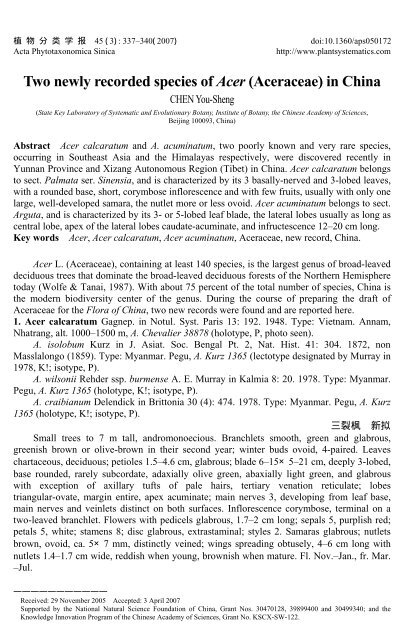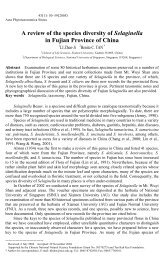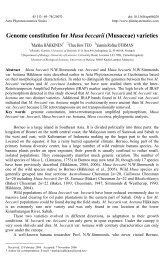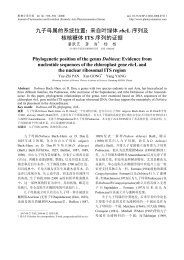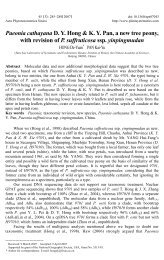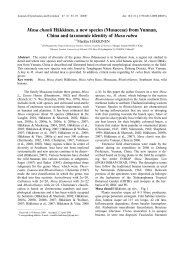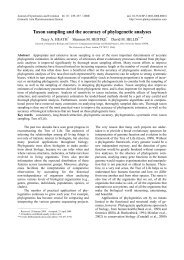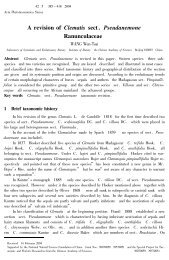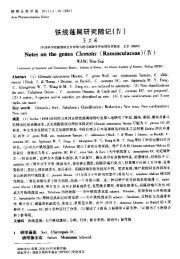Two newly recorded species of Acer (Aceraceae) in China
Two newly recorded species of Acer (Aceraceae) in China
Two newly recorded species of Acer (Aceraceae) in China
You also want an ePaper? Increase the reach of your titles
YUMPU automatically turns print PDFs into web optimized ePapers that Google loves.
45 (3): 337–340(2007)<br />
Acta Phytotaxonomica S<strong>in</strong>ica<br />
doi:10.1360/aps050172<br />
http://www.plantsystematics.com<br />
<strong>Two</strong> <strong>newly</strong> <strong>recorded</strong> <strong>species</strong> <strong>of</strong> <strong>Acer</strong> (<strong>Acer</strong>aceae) <strong>in</strong> Ch<strong>in</strong>a<br />
CHEN You-Sheng<br />
(State Key Laboratory <strong>of</strong> Systematic and Evolutionary Botany, Institute <strong>of</strong> Botany, the Ch<strong>in</strong>ese Academy <strong>of</strong> Sciences,<br />
Beij<strong>in</strong>g 100093, Ch<strong>in</strong>a)<br />
Abstract <strong>Acer</strong> calcaratum and A. acum<strong>in</strong>atum, two poorly known and very rare <strong>species</strong>,<br />
occurr<strong>in</strong>g <strong>in</strong> Southeast Asia and the Himalayas respectively, were discovered recently <strong>in</strong><br />
Yunnan Prov<strong>in</strong>ce and Xizang Autonomous Region (Tibet) <strong>in</strong> Ch<strong>in</strong>a. <strong>Acer</strong> calcaratum belongs<br />
to sect. Palmata ser. S<strong>in</strong>ensia, and is characterized by its 3 basally-nerved and 3-lobed leaves,<br />
with a rounded base, short, corymbose <strong>in</strong>florescence and with few fruits, usually with only one<br />
large, well-developed samara, the nutlet more or less ovoid. <strong>Acer</strong> acum<strong>in</strong>atum belongs to sect.<br />
Arguta, and is characterized by its 3- or 5-lobed leaf blade, the lateral lobes usually as long as<br />
central lobe, apex <strong>of</strong> the lateral lobes caudate-acum<strong>in</strong>ate, and <strong>in</strong>fructescence 12–20 cm long.<br />
Key words <strong>Acer</strong>, <strong>Acer</strong> calcaratum, <strong>Acer</strong> acum<strong>in</strong>atum, <strong>Acer</strong>aceae, new record, Ch<strong>in</strong>a.<br />
<strong>Acer</strong> L. (<strong>Acer</strong>aceae), conta<strong>in</strong><strong>in</strong>g at least 140 <strong>species</strong>, is the largest genus <strong>of</strong> broad-leaved<br />
deciduous trees that dom<strong>in</strong>ate the broad-leaved deciduous forests <strong>of</strong> the Northern Hemisphere<br />
today (Wolfe & Tanai, 1987). With about 75 percent <strong>of</strong> the total number <strong>of</strong> <strong>species</strong>, Ch<strong>in</strong>a is<br />
the modern biodiversity center <strong>of</strong> the genus. Dur<strong>in</strong>g the course <strong>of</strong> prepar<strong>in</strong>g the draft <strong>of</strong><br />
<strong>Acer</strong>aceae for the Flora <strong>of</strong> Ch<strong>in</strong>a, two new records were found and are reported here.<br />
1. <strong>Acer</strong> calcaratum Gagnep. <strong>in</strong> Notul. Syst. Paris 13: 192. 1948. Type: Vietnam. Annam,<br />
Nhatrang, alt. 1000–1500 m, A. Chevalier 38878 (holotype, P, photo seen).<br />
A. isolobum Kurz <strong>in</strong> J. Asiat. Soc. Bengal Pt. 2, Nat. Hist. 41: 304. 1872, non<br />
Masslalongo (1859). Type: Myanmar. Pegu, A. Kurz 1365 (lectotype designated by Murray <strong>in</strong><br />
1978, K!; isotype, P).<br />
A. wilsonii Rehder ssp. burmense A. E. Murray <strong>in</strong> Kalmia 8: 20. 1978. Type: Myanmar.<br />
Pegu, A. Kurz 1365 (holotype, K!; isotype, P).<br />
A. craibianum Delendick <strong>in</strong> Brittonia 30 (4): 474. 1978. Type: Myanmar. Pegu, A. Kurz<br />
1365 (holotype, K!; isotype, P).<br />
<br />
Small trees to 7 m tall, andromonoecious. Branchlets smooth, green and glabrous,<br />
greenish brown or olive-brown <strong>in</strong> their second year; w<strong>in</strong>ter buds ovoid, 4-paired. Leaves<br />
chartaceous, deciduous; petioles 1.5–4.6 cm, glabrous; blade 6–155–21 cm, deeply 3-lobed,<br />
base rounded, rarely subcordate, adaxially olive green, abaxially light green, and glabrous<br />
with exception <strong>of</strong> axillary tufts <strong>of</strong> pale hairs, tertiary venation reticulate; lobes<br />
triangular-ovate, marg<strong>in</strong> entire, apex acum<strong>in</strong>ate; ma<strong>in</strong> nerves 3, develop<strong>in</strong>g from leaf base,<br />
ma<strong>in</strong> nerves and ve<strong>in</strong>lets dist<strong>in</strong>ct on both surfaces. Inflorescence corymbose, term<strong>in</strong>al on a<br />
two-leaved branchlet. Flowers with pedicels glabrous, 1.7–2 cm long; sepals 5, purplish red;<br />
petals 5, white; stamens 8; disc glabrous, extrastam<strong>in</strong>al; styles 2. Samaras glabrous; nutlets<br />
brown, ovoid, ca. 57 mm, dist<strong>in</strong>ctly ve<strong>in</strong>ed; w<strong>in</strong>gs spread<strong>in</strong>g obtusely, 4–6 cm long with<br />
nutlets 1.4–1.7 cm wide, reddish when young, brownish when mature. Fl. Nov.–Jan., fr. Mar.<br />
–Jul.<br />
<br />
Received: 29 November 2005 Accepted: 3 April 2007<br />
Supported by the National Natural Science Foundation <strong>of</strong> Ch<strong>in</strong>a, Grant Nos. 30470128, 39899400 and 30499340; and the<br />
Knowledge Innovation Program <strong>of</strong> the Ch<strong>in</strong>ese Academy <strong>of</strong> Sciences, Grant No. KSCX-SW-122.
338<br />
Acta Phytotaxonomica S<strong>in</strong>ica Vol. 45<br />
Ch<strong>in</strong>a. Yunnan ( ): J<strong>in</strong>ghong ( ), Menglong ( ), Mengsong ( ), <strong>in</strong> ra<strong>in</strong><br />
forest, alt. 1700 m, 1998-04, H. Wang ( ) 6215 (PE).<br />
Thailand. Loei: Mt. Phu Krad<strong>in</strong>g, C. F. van Beusekom & C. Phengklai 3145 (K);<br />
Phukrad<strong>in</strong>g, L. B. Abbe et al. 9453 (K); Poo Kradeng, F. Flot 7505 (K). Chiangmai: Doi<br />
Khun Huai Pong, B. Hansen & T. Smit<strong>in</strong>and 12861 (K).<br />
Distribution: Ch<strong>in</strong>a (Yunnan), Myanmar, Thailand, Vietnam. Scattered near streams <strong>in</strong><br />
the ra<strong>in</strong> forest at elevations between alt. 1200 to 2400 m.<br />
<strong>Acer</strong> calcaratum is a poorly known <strong>species</strong> distributed <strong>in</strong> Myanmar, Thailand and<br />
Vietnam (Shimizu et al., 1981; Santisuk, 1998). Gagnepa<strong>in</strong> (1948) described this <strong>species</strong><br />
based on A. Chevalier 38878 (P) from Vietnam and noted that it is easily confused with A.<br />
isolobum Kurz and A. tonk<strong>in</strong>ense Lecomte. <strong>Acer</strong> isolobum was described from Myanmar and<br />
is <strong>in</strong> fact a later homonym <strong>of</strong> A. isolobum Masslalongo (Murray, 1978; Delendick, 1978; van<br />
Gelderen, 1994). Murray (1978) and Delendick (1978) provided two new names for A.<br />
isolobum Kurz respectively: A. wilsonii Rehder ssp. burmense A. E. Murray and A.<br />
craibianum Delendick, but these two taxa are <strong>in</strong> fact synonyms <strong>of</strong> <strong>Acer</strong> calcaratum (Shimizu<br />
et al., 1981).<br />
The 3-lobed leaf shape <strong>of</strong> <strong>Acer</strong> calcaratum is somewhat similar to that <strong>of</strong> A. wilsonii<br />
Rehder, A. tonk<strong>in</strong>ense, A. fenzelianum Hand.-Mazz., A. osmastoni Gamble, and A. chapaense<br />
Gagnep. <strong>Acer</strong> calcaratum differs from A. wilsonii by its short corymbose <strong>in</strong>florescences,<br />
sepals purplish red, samaras much larger and usually with only one well-developed <strong>in</strong> each<br />
<strong>in</strong>florescence, while A. wilsonii is characterized by its long droop<strong>in</strong>g paniculate<br />
<strong>in</strong>florescences, sepals greenish yellow, samaras much smaller and numerous (Santisuk, 1998),<br />
and leaves occasionally with two additional basal lobes (van Gelderen, 1994).<br />
Murray (1970) treated A. calcaratum as a synonym <strong>of</strong> A. tonk<strong>in</strong>ense ssp. fenzelianum<br />
(Hand.-Mazz.) E. Murray, but more recently <strong>Acer</strong> calcaratum, A. tonk<strong>in</strong>ense, and A.<br />
fenzelianum have all been treated as good <strong>species</strong> (Shimizu et al., 1981). Valder (1975) once<br />
mistook a tree <strong>of</strong> A. calcaratum from Thailand as A. tonk<strong>in</strong>ense because <strong>of</strong> its 3-lobed leaves<br />
(Shimizu et al., 1981). <strong>Acer</strong> tonk<strong>in</strong>ense is characterized by its long paniculate <strong>in</strong>florescences<br />
and leaves be<strong>in</strong>g ovate, shallowly 3-lobed or sometimes with two additional basal lobes, the<br />
base usually cordate, petioles stout, 2–2.5 cm long, glabrous, samaras small, 3–3.5 cm long,<br />
glabrous. <strong>Acer</strong> fenzelianum is characterized by its leaves be<strong>in</strong>g oblong, 10–136–10 cm,<br />
very shallowly 3-lobed, lateral lobes smaller and slightly divergent, base obtuse, petioles<br />
stout, 2–3 cm long, tomentose, <strong>in</strong>florescences corymbose, pedicels tomentose, and samaras<br />
pubescent, 3.5–3.8 cm long.<br />
<strong>Acer</strong> osmastoni Gamble was described from the Sikkim Himalayas <strong>in</strong> India, it differs<br />
from A. calcaratum by its paniculate <strong>in</strong>florescence, leaves be<strong>in</strong>g sometimes unlobed, and<br />
samaras smaller. Van Gelderen’s (1994) treatment <strong>of</strong> this taxon as a synonym <strong>of</strong> A.<br />
calcaratum is not accepted here.<br />
<strong>Acer</strong> chapaense was described from northern Vietnam based on Pételot 5824 (P). Its<br />
leaves are very similar to those <strong>of</strong> A. calcaratum. Rushforth (1994) found A. chapaense has<br />
milky sap and greenish bark and is closest to A. amplum Rehder and belongs to sect.<br />
Platanoidea Pax. After exam<strong>in</strong>ation <strong>of</strong> type specimens, I found A. chapaense to be the same<br />
with A. amplum var. jianshuiense W. P. Fang, which is characterized by its leaves be<strong>in</strong>g<br />
broadly 3-lobed, basally 5-nerved, base rounded, lobes entire, <strong>in</strong>florescences corymbose,<br />
nutlets compressed, and branchlets bark green.<br />
The systematic position <strong>of</strong> <strong>Acer</strong> calcaratum has seldom been discussed, but van<br />
Gelderen (1994) placed it under sect. Palmata Pax ser. S<strong>in</strong>ensia Pojárkova.<br />
To date, <strong>in</strong> Ch<strong>in</strong>a, <strong>Acer</strong> calcaratum has been found <strong>in</strong> only one locality <strong>of</strong> the
No. 3 CHEN: <strong>Two</strong> <strong>newly</strong> <strong>recorded</strong> <strong>species</strong> <strong>of</strong> <strong>Acer</strong> (<strong>Acer</strong>aceae) <strong>in</strong> Ch<strong>in</strong>a 339<br />
southernmost part <strong>of</strong> Yunnan Prov<strong>in</strong>ce border<strong>in</strong>g Myanmar. Thus, it is a critically endangered<br />
<strong>species</strong> <strong>in</strong> Ch<strong>in</strong>a.<br />
2. <strong>Acer</strong> acum<strong>in</strong>atum Wall. ex D. Don, Prod. Fl. Nepal 279. 1825; Pax <strong>in</strong> Engl. Pflanzenr. 163<br />
(8): 15. 1902; Kitamura <strong>in</strong> Kihara Fauna Fl. Nepal Himalaya 1744. 1955; Banerji & S. Das <strong>in</strong><br />
Indian Forester 97 (5): 248. 1971; van Gelderen et al., Maples <strong>of</strong> the World 165. 1994; van<br />
Gelderen & D. M. van Gelderen, Maples for Gardens 29. 1999. Type: India. Sr<strong>in</strong>agar, Wallich<br />
1225, pro parte (lectotype here designated, K!)<br />
<br />
Multi-stemmed small trees, to 10 m tall, dioecious. Branches <strong>of</strong>ten reddish green,<br />
smooth, glabrous; trunk green. Bud scales <strong>in</strong> pairs. Petioles <strong>of</strong>ten reddish, 5–10 cm,<br />
pubescent; leaf blade 6–12 cm long and about as wide, base subcordate-truncate, marg<strong>in</strong><br />
sharply serrate, <strong>of</strong>ten doubly toothed, apex caudate-acum<strong>in</strong>ate, acumen 1–2 cm, abaxially<br />
glabrescent except hirsute <strong>in</strong> axils <strong>of</strong> secondary ve<strong>in</strong>s, secondary ve<strong>in</strong>s 5, 3–5-lobed, basal<br />
lobes <strong>in</strong>significant, lobes triangular, apex acum<strong>in</strong>ate. Flowers greenish, dioecious, 4-merous.<br />
Male <strong>in</strong>florescence corymbose, axillary from leafless buds, female <strong>in</strong>florescence racemose,<br />
term<strong>in</strong>al or axillary from mixed buds. Sepals 4, oblong, 3–4 mm long. Petals 4, ovate, shorter<br />
than sepals. Stamens 4–6, <strong>in</strong>serted outside disc. Ovary glabrous; style long, connate to about<br />
halfway. Infructescence 12–20 cm long; samaras 3–4 cm long; w<strong>in</strong>gs spread<strong>in</strong>g at right<br />
angles; nutlets rugose. Fl. Mar.–Apr., fr. Sept.<br />
Ch<strong>in</strong>a. Xizang ( ): Yadong ( ), Xigou ( ), alt. 3100 m, 1975-10-23, Xizang Exped. (<br />
) 56 (PE); Jilong ( ): alt. 2750 m, 1981-09-14, Z. C. Ni ( ) 2227 (PE).<br />
<strong>Acer</strong> acum<strong>in</strong>atum is endemic to the Himalayas, distributed <strong>in</strong> northern India, Kashmir,<br />
Nepal and northern Pakistan. The specimens from Xizang represent the first record <strong>of</strong> this<br />
<strong>species</strong> <strong>in</strong> Ch<strong>in</strong>a.<br />
<strong>Acer</strong> acum<strong>in</strong>atum belongs to sect. Arguta Rehder. The only <strong>species</strong> <strong>in</strong> the Himalayan<br />
flora similar to this <strong>species</strong> is A. stachyophyllum Hiern, but our <strong>species</strong> differs by its leaf<br />
blades be<strong>in</strong>g 3- or 5-lobed, lateral lobes usually as long as central lobe, apex <strong>of</strong> lateral lobes<br />
caudate-acum<strong>in</strong>ate, and <strong>in</strong>fructescence much longer, 12–20 cm.<br />
Acknowledgements The author is grateful to the curators <strong>of</strong> the herbaria (K, P, PE) for<br />
their help to access to the herbarium collections and/or the loan <strong>of</strong> type specimens.<br />
References<br />
Delendick T J. 1978. <strong>Acer</strong> craibianum (<strong>Acer</strong>aceae), a new name for a maple <strong>of</strong> southeast Asia. Brittonia 30:<br />
473–476.<br />
Gagnepa<strong>in</strong> F. 1948. <strong>Acer</strong> Nouveaux d’Indoch<strong>in</strong>e. Notulae Systematicae 13: 192–195.<br />
Murray A E. 1970. A Monograph <strong>of</strong> the <strong>Acer</strong>aceae. Ph.D. Dissertation. Philadelphia: Pennsylvania State<br />
University.<br />
Murray A E. 1978. <strong>Acer</strong> notes no. 8. Kalmia 8: 17–20.<br />
Rushforth K. 1994. <strong>Acer</strong> chapaense and its systematic position. International Dendrology Society Year Book.<br />
London: International Dendrology Society. 69–70.<br />
Santisuk T. 1998. A systematic study <strong>of</strong> the genus <strong>Acer</strong> (<strong>Acer</strong>aceae) <strong>in</strong> Thailand. Natural History Bullet<strong>in</strong> <strong>of</strong><br />
the Siam Society 46: 93–104.<br />
Shimizu T, Toyokuni H, Koyama H, Santisuk T, Smitiand T. 1981. Contributions to the Flora <strong>of</strong> Southeast<br />
Asia. VI. Taxonomy and phytogeography <strong>of</strong> some temperate <strong>species</strong> <strong>in</strong> Thailand. (2). Acta<br />
Phytotaxonomica et Geobotanica 21(1–4): 37–46.<br />
Valder P G. 1975. A maple <strong>in</strong> Thailand. Garden 100: 497.<br />
Van Gelderen D M. 1994. Maple <strong>species</strong> and <strong>in</strong>fraspecific taxa. In: Van Gelderen D M, de Jong P C, Oterdoom<br />
H J eds. Maples <strong>of</strong> the World. Portland, Oregon: Timber Press. 105–239.<br />
Wolfe J A, Tanai T. 1987. Systematics, phylogeny, and distribution <strong>of</strong> <strong>Acer</strong> (maples) <strong>in</strong> the Cenozoic <strong>of</strong> the<br />
western North America. Journal <strong>of</strong> the Faculty <strong>of</strong> Science, Hokkaido University, series IV. Geology and
340<br />
Acta Phytotaxonomica S<strong>in</strong>ica Vol. 45<br />
M<strong>in</strong>eralogy 22 (1): 1–246.<br />
<br />
<br />
(<br />
, 100093)<br />
<strong>Acer</strong> calcaratum Gagnep. <strong>Acer</strong> acum<strong>in</strong>atum Wall. ex D. Don<br />
<br />
, <br />
, <br />
sect. Palmata ser. S<strong>in</strong>ensia, <br />
, , ,<br />
<br />
, <br />
sect. Arguta, 3<br />
5, <br />
, , 12–20 cm<br />
<br />
; ; ;


